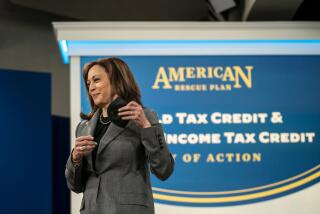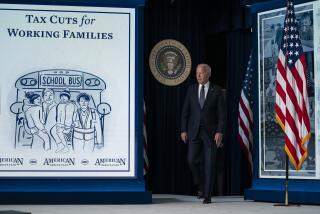COLUMN LEFT : Recovering the Strengths of Ozzie & Harriet : 1990’s median-income family is taxed at 25%; 30 years ago it was only 14%. Let’s fix the tax code.
It used to be that people talking about the mythical television family of Ozzie and Harriet did so with thinly concealed contempt. After all, that family, with its stay-at-home Mom, its off-to-work Dad and its two perfect kids was an anachronism, corny, uncool.
Well, times have changed and the Ozzie and Harriet metaphor is getting a more congenial response as more and more people realize that the American family didn’t evolve into a post-traditional utopia. Mostly it just disintegrated--with consequences borne by the children. While the disintegration is most acute among the urban poor, the crisis of the American family extends to the members of the vast middle class. It has become so pervasive an issue that a coalition of liberals and conservatives is forming around the first step in a plan to come to the aid of American families, using an old standby of the tax code--the personal exemption.
The villain in the family crisis is primarily economic. It is not, as some would have us think, the women’s movement, whose efforts to open up jobs for women and fight for equal pay were essential in blunting the effects of the real villain--a prolonged period, beginning in 1973, of practically flat economic growth brought on by low productivity. Meanwhile, the staples of a middle-class life--a home, a college education and good health care--zoomed in price. To maintain the middle-class lifestyle, women went to work and families became smaller.
Add the villain of increasingly high taxes and you have the beginning of a political consensus on family tax policy. Alan Carlson of the American Enterprise Institute claims that between 1967 and 1984 “even residual gains made by sending additional family members into the paid labor force were wiped out by federal taxes.”
Combine the tax burden on families with the growth in state and local taxes and in the Social Security tax--which, as Sen. Daniel Patrick Moynihan (D-N.Y.) has shown us, falls disproportionately on the average wage earner--and you have a staggering increase in the tax burden on average American families. The tax burden on a median-income family in 1990 will amount to about 25% of family income as opposed to only 14% just 30 years ago.
In the days of Ozzie and Harriet, American tax policy was designed not to take away the money that a family needed to raise a child. According to Eugene Steuerle, the economist who has done the most work on this topic, the personal exemption in 1948 was $600 and median family income was $3,187. This meant that a family of four at median income paid a minuscule 3% of its income in federal taxes, compared with 9.1% today.
But the government allowed the value of the personal exemption to erode. Had it kept its real economic value today, the family of four at median income ($36,805 in 1987) should have been able to deduct about $30,000 from its income taxes--thus leaving only a few thousand dollars subject to federal taxes. Instead the family got to deduct only $8,200. Women have gone to work to pay the taxes and the baby-sitter. No wonder the number of women who say they’d quit work if they had enough money increased from 35% in 1987 to 56% in 1990.
Awareness of the tax burden on average families has created an unusual convergence of opinion in political circles. People with roots in more liberal politics recognized in recent proposals to increase the personal exemption an American version of the children’s allowance that is in widespread use in all the other industrialized countries of the world. Conservative scholars latched on to an increased personal exemption as a non-bureaucratic way to aid families and as a way to cut taxes, which they never lose a chance to do.
The convergence is not, of course, without its problems. How do you replace the revenue lost by giving such large tax breaks to families with children? One way is to limit the increased exemption to children of preschool age, since day care is most expensive for those children. The increased money from a “children’s exemption” could be used to pay for day care or to help the family live on one income.
But still, the proposition is expensive and will test the resolve of our leaders to come to the aid of the family. The historian Barbara Whitehead has pointed out, “Raising children isn’t identified with the public interest. It’s viewed as a private activity, a lifestyle of choice pursued for reasons of individual preference and taste.”
But as the family has disintegrated and children suffer, more and more people from all parts of the political spectrum have come to the realization that parenting is an activity with vast social consequences. Compared with the other things that our government spends money on, we could do worse than to give it to parents.
More to Read
Inside the business of entertainment
The Wide Shot brings you news, analysis and insights on everything from streaming wars to production — and what it all means for the future.
You may occasionally receive promotional content from the Los Angeles Times.










